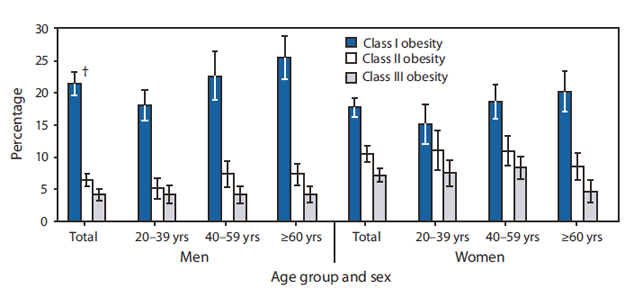* Class I obesity defined as a body mass index (BMI: weight [kg] / height [m2]) ≥30 but <35. Class II obesity defined as a BMI ≥35 but <40. Class III obesity defined as a BMI ≥40.
† 95% confidence interval.
During 2007--2008, men had a higher prevalence of class I obesity (21.5%) than women (17.8%). However, women had a higher prevalence of class II (10.5%) and class III (7.2%) obesity then men (6.5% and 4.2%). The prevalence of class I obesity significantly increased with age in men, but not in women. The prevalence of class II and class III obesity did not differ significantly by age for either men or women.
SOURCES: Flegal KM, Carroll MD, Ogden CL, Curtin LR. Prevalence and trends in obesity among US adults 1999--2008. JAMA 2010;303:235--41.
National Health and Nutrition Examination Survey, 2007--2008. Available at http://www.cdc.gov/nchs/nhanes.htm.
Alternate Text: The figure above shows the prevalence of obesity (class I, II, and III) among adults aged ≥20 years, by age group and sex, from the National Health and Nutrition Examination Survey, from 2007-2008. During 2007-2008, men had a higher prevalence of class I obesity (21.5%) than women (17.8%). However, women had a higher prevalence of class II (10.5%) and class III (7.2%) obesity then men (6.5% and 4.2%). The prevalence of class I obesity significantly increased with age in men, but not in women. The prevalence of class II and class III obesity did not differ significantly by age for either men or women.
 ShareCompartir
ShareCompartir



